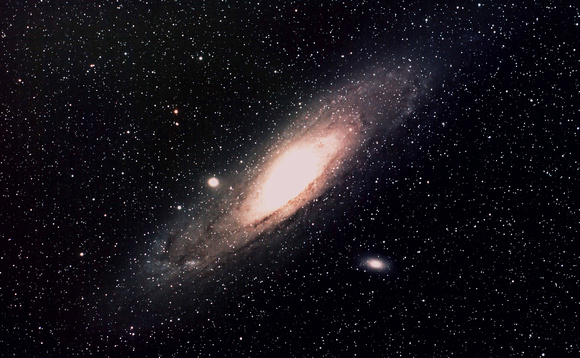M31 - Andromeda Galaxy
Other Names: M31, NGC 224, Andromeda Galaxy
Optics: Borg Astrograph 101ED at f/4.1
Mount: Atlas EQG using The Sky6 and EQMOD
Camera: Canon EOS 50D [ UV/IR filter modification by Hap Griffin ]
Filters: IDAS Light Pollution Suppression (LPS) Filter
Exposure: 132 Mins [44 x 130s at ISO 800]
Accessories: Auto guided with Borg 45ED and Orion Starshoot Auto guider using PHD
Location: Calgary, AB
Date: October 30th, 2010
Notes: Processing: Image acquisition with Maxim DSLR. Image calibration, align, and combine in Maxim DSLR. Levels, Layers, Curves, crop and resize in Photoshop.
Calibrated w/10 Darks, 40 Bias, 40 Flats using light box, Ambient temperature was +5C
The Andromeda Galaxy (pronounced /ænˈdrɒmədə/) is a spiral galaxy approximately 2,500,000 light-years (1.58×1011 AU) away[4] in the constellation Andromeda. It is also known as Messier 31, M31, or NGC 224, and is often referred to as the Great Andromeda Nebula in older texts. Andromeda is the nearest spiral galaxy to the Milky Way, but not the closest galaxy overall. As it is visible from Earth as a faint smudge on a moonless night, it is one of the farthest objects visible to the naked eye, and can be seen even from urban areas with binoculars. It gets its name from the area of the sky in which it appears, the Andromeda constellation, which was named after the mythological princess Andromeda. Andromeda is the largest galaxy of the Local Group, which consists of the Andromeda Galaxy, the Milky Way Galaxy, the Triangulum Galaxy, and about 30 other smaller galaxies. Although the largest, Andromeda may not be the most massive, as recent findings suggest that the Milky Way contains more dark matter and may be the most massive in the grouping.[10] The 2006 observations by the Spitzer Space Telescope revealed that M31 contains one trillion (1012) stars,[7] more than the number of stars in our own galaxy, which is estimated to be c. 200-400 billion.[11]
While the 2006 estimates put the mass of the Milky Way to be ~80% of the mass of Andromeda, which is estimated to be 7.1 × 1011 solar masses,[2] a 2009 study concluded that Andromeda and the Milky Way are about equal in mass.[12]
At an apparent magnitude of 3.4, the Andromeda Galaxy is notable for being one of the brightest Messier objects,[13] making it easily visible to the naked eye even when viewed from areas with moderate light pollution. Although it appears more than six times as wide as the full Moon when photographed through a larger telescope, only the brighter central region is visible to the naked eye or when viewed using a binoculars or a small telescope


